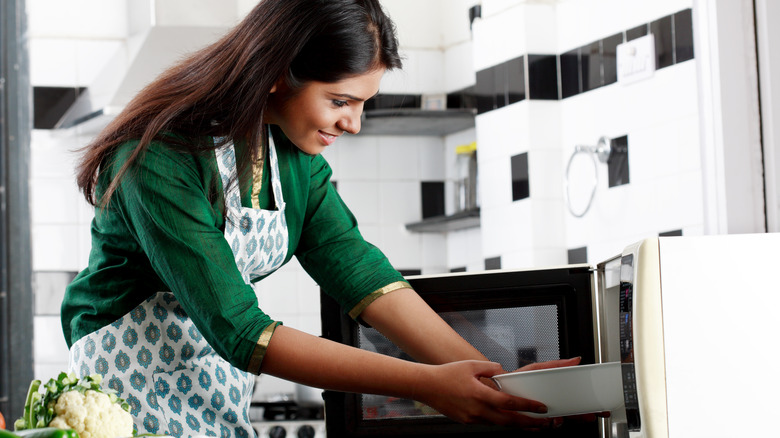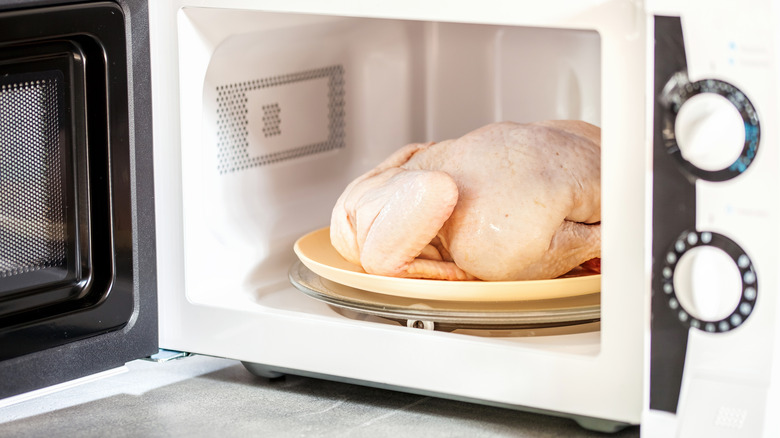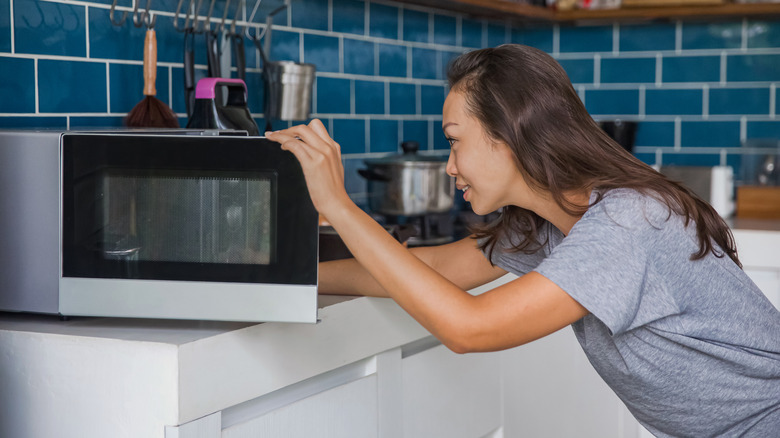The USDA Warns Against Cooking This One Food In The Microwave
Your microwave can be so convenient when you're in a hurry. You can have a frozen meal ready for the table in just a few minutes.
Yet we often believe foods are cooked properly until we take a bite into them, only to find it still frozen or cold in the middle. If you haven't noticed, certain foods like ground beef, fruits, and vegetables cook better in the microwave because they have more moisture than eggs, cheese, and solid meat. That's why it's often better to cook these more solid foods at 50% power for a little longer so the heat can penetrate the inside of the food without excessively drying the outside.
Because food doesn't cook as evenly in a microwave as in a conventional oven, it's important to test the temperature of your food so you know any harmful bacteria like salmonella are destroyed in the cooking process. However, even if your food thermometer says your stuffed poultry has reached the safe, minimal temperature of 165 degrees Fahrenheit, the U.S. Department of Agriculture (USDA) doesn't recommend cooking whole, stuffed poultry in the microwave.
Why stuffed poultry is tough to cook in a microwave
Microwave ovens generate electromagnetic waves that are low frequency but have a relatively long wavelength. While they may be classified as radio waves, they are higher in frequency than other radio waves. This higher frequency gives them enough energy that they can cause the molecules in the food to vibrate and create heat (per cK-12).
It might seem that a microwave cooks food from the inside out since the temperature in your microwave oven never seems to be hotter than your food (per Maytag). However, the USDA says this isn't entirely accurate. The electromagnetic waves can't reach more than an inch or two into your food. Any food that's thicker than this only gets heated on the outer edges. That's why foods that are dense need a little more time to sit after heating so that heat can penetrate the inside of the food.
If you have bones in your food, such as those found in a stuffed chicken, the bones can prevent the meat from cooking all the way through. The USDA says that even though food cooks quickly in the microwave, stuffing inside the poultry might not get hot enough to be safe to eat.
How to cook food safely in the microwave
To make sure your food cooks evenly and destroys harmful bacteria, the USDA suggests checking several spots to make sure it's all cooked to the right temperature. Ground meats and eggs should reach 160 degrees, while poultry needs to be a little higher at 165 degrees. Fish and other types of meat should be cooked to 145 degrees. To allow the heat to fully cook the food, let it stand for at least three minutes after cooking.
Food cooks a little more evenly in the microwave if you arrange it evenly in the cooking dish. Adding some water to the dish will not only help with the cooking, but it will also help retain some of the food's vitamins and minerals (via Harvard Medical School). The USDA says it's also a good idea to cover the dish with a lid or plastic wrap, but be sure not to let the plastic touch the food. You'll also want to open the lid or plastic wrap a little to allow room for steam. Although turntables in microwaves help food cook a little more evenly, it's always a good idea to stir or flip foods throughout the cooking process to make sure it doesn't have any remaining harmful bacteria.



